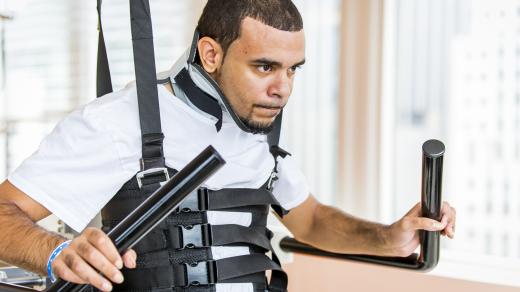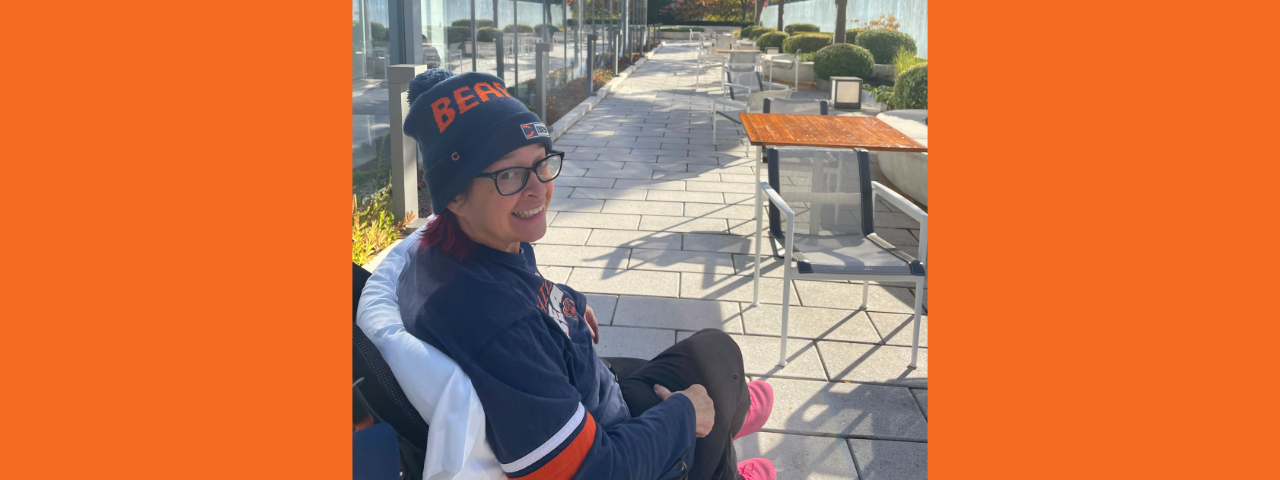Body
Kyle C. had been enjoying a typical hot Phoenix summer, was recently married and was about to start a new job. Then, without warning, he had a brainstem stroke that caused a rare condition called locked-in syndrome (LIS).
Although his cognitive abilities were completely intact, he couldn’t speak or move. His near-total paralysis meant he needed both breathing and feeding tubes.
“The ICU doctor said I’d never walk, talk or breathe on my own again,” he said.
Body
LIS is extremely rare — affecting fewer than 2 percent of people with stroke. In fact, the majority of hospitals and physicians never see a single case. When his family learned Shirley Ryan AbilityLab had extensive experience with LIS and stroke recovery, and had specialists in neurorehabilitation, they knew they had to get him here.
“Despite Kyle’s near-complete paralysis, when we looked at him and when he looked at us, we just knew he was still in there,” said his wife Michelle.
After seven weeks in an acute-care hospital, Kyle came to Shirley Ryan AbilityLab.
Breaking Out: Starting Stroke Recovery
Body
When Kyle first arrived, he couldn’t speak, and had very minimal movement in his hand.
Michelle recalls her awe and disbelief at seeing Kyle walking with assistance on a treadmill — on only his second day in rehabilitation. She had worried whether he’d be able to hold up his head, let alone walk on a treadmill.
“His therapist told me that they would be rigorous and intense, but they’d scale back, if necessary.” They never needed to — Kyle wanted to be challenged.
“A lot of the stuff he had to do was very hard,” said Richard Harvey, MD, Clinical Chair, Shirley Ryan AbilityLab Brain Innovation Center. “It was very physically challenging, it was mentally exhausting. That didn’t phase him.”
One by one, he reached every goal he set for himself. The young man who arrived just a few months earlier, unable to speak or move, was now holding entire conversations with his therapists, walking on his own with just a walker, and dressing, bathing and feeding himself.
It was exhausting, but Kyle was beyond motivated.
“Kyle is one person who’s had this diagnosis and his recovery is Kyle’s recovery,” said Dr. Harvey. “But every patient who has locked-in syndrome has a different pathway. We will work as hard as we can to get the most recovery we can get.”
Along the way, Kyle participated in research opportunities. He also graduated from inpatient rehabilitation to Shirley Ryan AbilityLab’s DayRehab level of care, where he worked on refining everyday skills and activities, from cooking to navigating inside and outside of his home.
Recovery Beyond Traditional Physical Therapy: “These programs are therapy”
Body
Throughout his inpatient stay, Kyle benefitted from an array of quality of life services. He received psychological counseling, met with a peer mentor, participated in art therapy and music therapy, and took advantage of every therapeutic recreational activity he could, including cycling, adaptive rock climbing, tennis and golf.
Kyle considers these experiences vital to his ongoing recovery. He fondly recalls the day Michelle and his mom joined him in a session of music therapy and how it provided such a wonderful moment of emotional connection.
“We all played different instruments and the focus was on creating something, not on what had happened to me,” he said. “I was doing something with the people I love without having to be reminded of where we were or why we were there.”
For someone who was very active before his stroke, Kyle appreciated the way his recreational therapist found ways to adapt any activity for him.
Meeting with a peer mentor not only helped Kyle cope with how his diagnosis would affect his life, but it also offered him a glimpse into how he can help others. He envisions being a peer mentor himself someday.
New Home, New Hope
Body
Now back home, Kyle remains focused on his continued recovery. He and Michelle moved into a new house and celebrated their first anniversary outside of the hospital. Additionally, Kyle got his driver’s license.
“It was quite a process, but I successfully passed all the tests,” he said. “Our car is being modified so that I can drive it on my own. This will be a huge step forward in my independence.”
After benefiting so much from art therapy at Shirley Ryan AbilityLab, Kyle made it a goal to learn as many different kinds of art as he could. Just recently, he showcased his art at Art in Motion, an annual event benefiting Shirley Ryan AbilityLab.
Kyle holds gratitude for his journey and those who have supported him.
“Throughout our time at Shirley Ryan AbilityLab, Michelle and I met so many people with stories as inspiring as ours. It is because of this organization that we are living the life that we have today,” he said. “The future looks bright for Michelle and me, and I can't wait to see where our life goes from here.”
Kyle is confident his progress will never end.
“I am going to come out of this experience better than I was,” he said.



